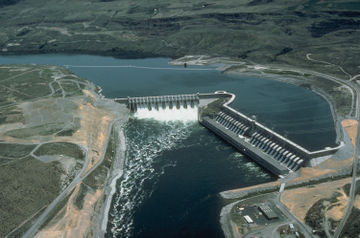Run-of-the-river systems: Difference between revisions
No edit summary |
J.williams (talk | contribs) m (1 revision imported) |
(No difference)
| |
Revision as of 18:22, 3 September 2015

Run-of-the-river hydroelectric systems are hydroelectric systems that harvest the energy from flowing water to generate electricity. The primary difference between this type of hydroelectric generation and others is that run-of-the-river primarily uses the flow rate of water to generate power instead of the power from falling water.[2] Another main difference between traditional hydropower is that run-of-the-river hydro is used in areas where there is little to no water storage, such as in a river.
There are several different classifications of run-of-the-river systems, based primarily on their capacity. The types are outlined in the table below:[3]
| Classification | Capacity |
| Micro | < 100 kW |
| Mini | 100 kW - 1 MW |
| Small | 1 - 50 MW |
It is important to note that some larger scale run-of-the-river plants exist, with outputs of hundreds or thousands of MW.
Operation
For a run-of-the-river system to be possible in a given location, there need to be two specific geographical features. The first is there must be a reasonably substantial flow rate, either from rainfall or a melting snowpack. As well, there must be enough of a tilt to the river to speed the water up significantly.[3]
In run-of-the-river systems, running water from a river is guided down a channel or penstock. The diverted water is brought to an electricity generating house. In this house, the force of the running water spins a turbine, driving a generator and generating electricity. After being used, water is fed back into the river downstream.[2] One major difference between large-scale conventional storage hydro is the absence of any dam or hydroelectric reservoir.[3]
Although run-of-the-river systems rely primarily on the power of fast moving rivers to generate electricity, many small hydro facilities use some sort of small-scale dam or weir to ensure enough water enters the system itself. Pondage is also used occasionally to store small amounts of water - plants that use pondage are generally more reliable as they compensate for any discrepancies in water flow.[3]
Comparison to Traditional Hydro
There are several benefits that exist as a result of using run-of-the-river hydro instead of traditional, dam based hydro. First, these large hydro dams are expensive and time consuming to build. Comparatively speaking, run-of-the-river systems are less expensive to build and can be built over a shorter period of time. Additionally, many areas where large hydro is used frequently - such as in Canada - have developed many of the existing favourable hydropower sites.[3] As well, some of the environmental problems associated with the flooding caused when reservoirs are used are eliminated when run-of-the-river hydro is used.[2]
Although there are some favourable aspects to run-of-the-river hydro, the output of it compared to large scale hydro is still significantly lower. As well, dam based hydroelectric generation still provides a lower cost per kWh despite the larger initial investment. Additionally, the absence of the dam contributes to a certain lack of reliability in the hydro system. If the water levels are depleted upstream, potentially due to drought conditions, there is less water to run the hydroelectric system.[3] A dam would provide backup, but no dam exists in these systems.
Environmental Impact
Compared to the combustion of fossil fuels, run-of-the-river hydro is responsible for fewer greenhouse gas emissions. Most of these emissions are a result of the construction of the system itself, but the operation of the plant itself contributes almost no emissions.[2] Additionally, the flooding of land associated with the creation of a reservoir in traditional hydropower is not an issue for run of river.
Although the emission impact of these systems is less than the combustion of fuels, there are other environmental impacts that must be taken into account. First, the manipulation of river flows can cause a significant number of environmental impacts. Any diversion in the river changes how the aquatic ecosystem works, which could affect fish populations and the health of the river overall. However, the small head difference in run-of-the-river systems allows for the construction of fish ladders, which could allow fish to move through the system without being harmed or having their migration routes interrupted.[3] As well, the changes in the river basin or water composition could increase species mortality, disrupt migration, or cause an imbalance in biodiversity. Finally, thermal pollution and increased turbidity of the exiting water are possible side effects of sending water through turbines and back into a river.[2]
Overall, it is difficult to determine whether or not the damage inflicted on the environment by run-of-the-river systems is outweighed by the relatively small output as compared to large hydro dams.
References
- ↑ Wikimedia Commons. (August 24, 2015). Chief Joseph Dam [Online]. Available: https://upload.wikimedia.org/wikipedia/commons/6/6c/Chief_Joseph_Dam.jpg
- ↑ 2.0 2.1 2.2 2.3 2.4 Green Energy Futures. (August 28, 2015). How it Works: Run of River [Online]. Available: http://www.greenenergyfutures.ca/episode/30-how-it-works-run-river-hydro-electric-power
- ↑ 3.0 3.1 3.2 3.3 3.4 3.5 3.6 EnergyBC. (August 28, 2015). Run-of-River Power [Online]. Available: http://www.energybc.ca/profiles/runofriver.html

